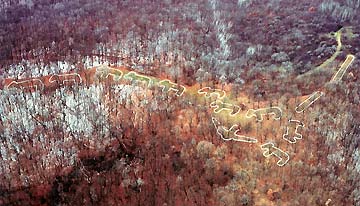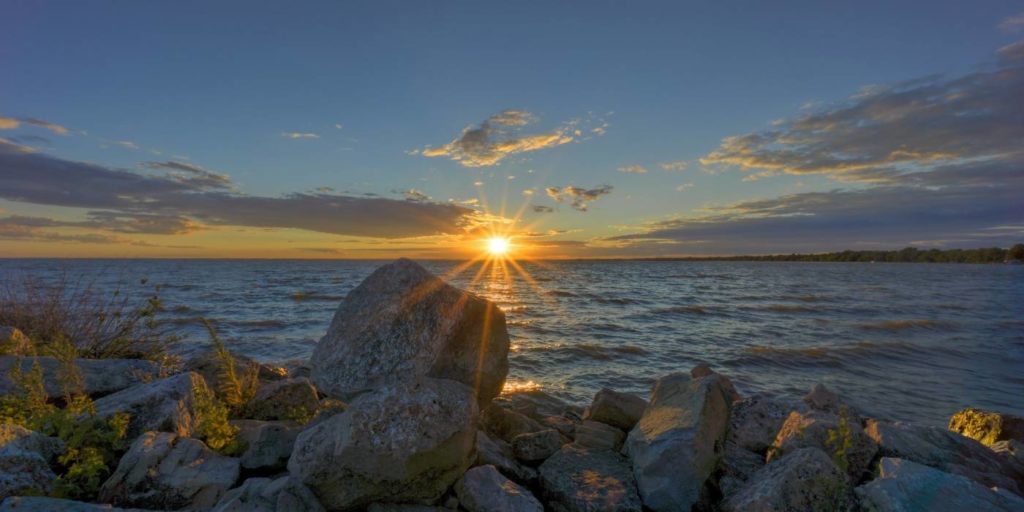A History in the Making: High Cliff’s Preserved Legacy
As the weather warms and the outdoors appeal to us much more than the inside, escaping to the trails, water or any nature location ranks at the top of many people’s summer plans. Yet, unlike the air-conditioned, modernized locations mentioned in my last post, these outdoor sites are preserved or untouched havens of nature, beckoning us to explore their beauties.
In order for a location to hold a legacy, drastic change is not always necessary. We can leave our mark by simply sustaining the area and appreciating its qualities.
This idea of preservation rings true in the Fox Cities most proud and most visited nature location: High Cliff State Park.

Forests, cliffs and teeming wildlife in its 1,187 acres make up the adventure hotspot of High Cliff. Founded as a park in 1956, High Cliff has seen little change since then; however, before its establishment, High Cliff had already been home to several other groups of people.
Dating back 1,000-1,500 years, High Cliff was first known to be inhabited by nomadic Siouan Indians who unknowingly made history without attempting to preserve it.
As we walk High Cliff’s trails today, signs alert us to effigy mounds (burial or ritual mounds) built by the Siouan Indians to honor their dead or to appeal to the water spirits the tribe worshipped. We might jump to conclusions and assume these mounds are similar in size to modern-day burials. Wrong assumption! These mounds can be up to hundreds of feet long–so long they’re especially hard to track or spot.

Thirty of these mounds were first spotted at High Cliff, yet now only nine remain: four panther-shaped mounds, two buffalo-shaped and conical mounds, and one linear mound. These shapes signify the status of those buried within: panthers most often meant a chief or leader, while the status lessened from buffalo to conical, and lastly, to linear.
This alteration to the land through effigy mounds now encompasses the ancient history of High Cliff that modern park-goers long to sustain. No other evidence still remains at High Cliff of this tribe’s existence besides their puzzling mounds, leaving most of the nature completely untouched yet adding a significant tribal legacy to Wisconsin.
Years after the Siouan Indians resided on the cliffs, modernization and expansion made its way to High Cliff. In 1855, the Cook & Brown Company opened a brickyard, bringing people and new construction. A general store, company office and post office quickly accompanied the operation, giving birth to the village named Clifton, after the limestone cliffs nearby.
As Clifton grew, the popularity of High Cliff’s ledges grew as well, yet the only access to the top was a hand-built path called the old “Indian Path.” Alex Hart was paid $200 dollars by Calumet County and given a pickaxe, shovel and a wheelbarrow to create the road, taking several years to complete and becoming a lasting memory of the steep climb to the top of the cliffs.
The new community thrived for nearly 60 years, adding a sawmill and growing in population. Yet after a shortage of clay for brick-making and a lack of lumber, the brickyards and the sawmill began to close down.
Not yet finished exploring High Cliff’s treasures, the Cook & Brown Company changed trades and opened a quarry around 1870, building the first kilns on the lakeshore. Unfortunately for the sustaining of High Cliff, these kilns caught fire and were relocated many times during the quarry’s operation.
Beginning to make a name for themselves, Clifton residents were forced to change their name in 1885 due to their shared name with another town in Wisconsin. In order to stop confusion and stand out as a town, Clifton became High Cliff, the memorable name we all find familiar today.
Eventually, the Cook & Brown Company became the Western Lime and Cement Company, a still-active business to this day. As business boomed in High Cliff, so did the city’s cultural life. The nightlife thrived with the High Cliff Dancing Pavillion, and soon in the 1920s, High Cliff expanded to include an amusement park, even adding a steam-powered merry-go-round.
High Cliff became the summer hotspot for excursion boats–days filled with warm weather and picnics and nights filled with dancing and endless excitement.
Generations established themselves on the cliffs for over a century, and their memories can be found in the old General Store–now a museum–in worn journals and papers. These generations continue to this day; descendants of the first High Cliff villagers linger in the local families, keeping the legacy alive.
You might be wondering, “if High Cliff became widely populated, why is it now mostly old rocky cliffs and worn-down trails?” The answer lies in the fact that about a century after its opening, the limestone available lost its luster, and the quarry dwindled until it closed its doors, signaling the end of its industrial days.

Local families moved in search of work, and the once lively town quieted. After the State of Wisconsin bought the land in 1954 in hopes of creating a state park, the last signs of the town were demolished. Only the general store and the ruins of the kilns remain, allowing for the town’s memory to live on. Nature overtook the tamed streets and worked cliffs and returned High Cliff to a vast land of wildlife, barring fading marks of its past inhabitants.
Now, 64 years after the park’s opening, High Cliff has experienced little change after its return to its natural state. This enchanting park now reveals the history of settlers and tribes while new generations find ways to leave their mark in carved letters or by taking personal pictures. You can discover more of High Cliff’s history on Wisconsin’s DNR website.
Though only trails, a few park attractions, and informative signs have transformed the cliffs, the park’s uses have certainly transformed from a dwelling or operational business to an escape into the wild for leisure, adventure, and discovery.
Current visitors’ connections with the outside world are satisfied in numerous forms at High Cliff: hiking, camping, biking, boating, canoeing and kayaking, horseback riding, swimming, and fishing to name a few. Six extensive trails offering glimpses of preserved mounds or Clifton ruins pave the way for these enjoyments.
Clifton’s modernizations are faintly mirrored in the park’s four picnic areas, especially in the merry-go-rounds. Summers still cause flocks of visitors to set High Cliff alive with activity, yet the wildlife around remains secluded and echoing louder than the rhythmic footsteps and playful laughter of genial excursions.

While community development–either individually or combined–commonly leads to new innovations and restorations, High Cliff presents a new perspective of impaction without physical alteration. Simply transforming an area’s use without changing its current appearance allows history to live on, yet naturally and without the need for intervention.
Our impact similarily evolves in our ability to preserve and admire, rather than add or demand change. Honoring past developments and allowing natural processes to continue undisturbed enables our impact to be found in our perspective rather than our physical mark.
History is not meant to be merely viewed or studied. It is meant to teach, inspire praise, and be upheld. Rather than expressing dismay at the quarry developed nearly a hundred years ago, we may replace those thoughts with admiration at the hard work of settlers and the still-intact past of Indian tribes.
Perhaps our legacy resides not in striving for an impact at all. Simply enjoying our surroundings and shifting our perspective to an appreciation for each era will give future generations the same admiration for our ability to continue to grow without forcing the change.
Like those before, let us live on the land, hike its trails, and experience its beauty, while our footprint lies unknowingly within the well-worn trails.










Leave a Comment